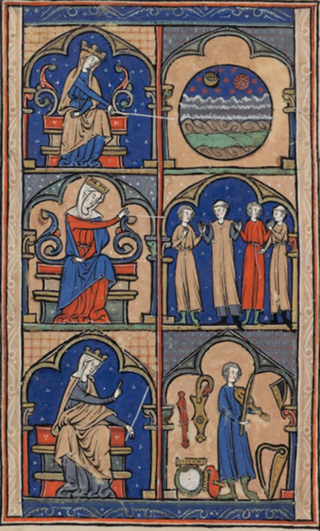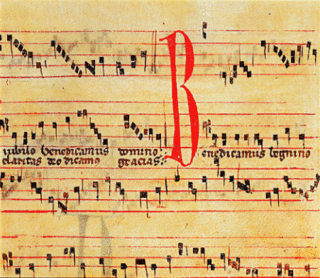
Medieval music encompasses the sacred and secular music of Western Europe during the Middle Ages, from approximately the 6th to 15th centuries. It is the first and longest major era of Western classical music and followed by the Renaissance music; the two eras comprise what musicologists generally term as early music, preceding the common practice period. Following the traditional division of the Middle Ages, medieval music can be divided into Early (500–1000), High (1000–1300), and Late (1300–1400) medieval music.
Plainsong or plainchant is a body of chants used in the liturgies of the Western Church. When referring to the term plainsong, it is those sacred pieces that are composed in Latin text. Plainsong was the exclusive form of Christian church music until the ninth century, and the introduction of polyphony.

Gregorian chant is the central tradition of Western plainchant, a form of monophonic, unaccompanied sacred song in Latin of the Roman Catholic Church. Gregorian chant developed mainly in western and central Europe during the 9th and 10th centuries, with later additions and redactions. Although popular legend credits Pope Gregory I with inventing Gregorian chant, scholars believe that it arose from a later Carolingian synthesis of the Old Roman chant and Gallican chant.
Pérotin was a composer associated with the Notre Dame school of polyphony in Paris and the broader ars antiqua musical style of high medieval music. He is credited with developing the polyphonic practices of his predecessor Léonin, with the introduction of three and four-part harmonies.
Organum is, in general, a plainchant melody with at least one added voice to enhance the harmony, developed in the Middle Ages. Depending on the mode and form of the chant, a supporting bass line may be sung on the same text, the melody may be followed in parallel motion, or a combination of both of these techniques may be employed. As no real independent second voice exists, this is a form of heterophony. In its earliest stages, organum involved two musical voices: a Gregorian chant melody, and the same melody transposed by a consonant interval, usually a perfect fifth or fourth. In these cases the composition often began and ended on a unison, the added voice keeping to the initial tone until the first part has reached a fifth or fourth, from where both voices proceeded in parallel harmony, with the reverse process at the end. Organum was originally improvised; while one singer performed a notated melody, another singer—singing "by ear"—provided the unnotated second melody. Over time, composers began to write added parts that were not just simple transpositions, thus creating true polyphony.
Johannes Cotto was a music theorist, possibly of English origin, most likely working in southern Germany or Switzerland. He wrote one of the most influential treatises on music of the Middle Ages, De musica, first printed by Gerbert in 1784. The treatise included unusually precise directions for composing chant and organum.

Alejandro Enrique Planchart was a Venezuelan-American musicologist, conductor, and composer. He was considered to be one of the leading scholars on the music of Guillaume Du Fay; more broadly, he was a specialist on music of the Middle Ages and early Renaissance music.

The Magnus Liber or Magnus liber organi, written in Latin, was a repertory of medieval music known as organum. This collection of organum survives today in three major manuscripts. This repertoire was in use by the Notre-Dame school composers working in Paris around the end of the twelfth and beginning of the thirteenth centuries, though it is well agreed upon by scholars that Leonin contributed a bulk of the organum in the repertoire. This large body of repertoire is known from references to a "magnum volumen" by Johannes de Garlandia and to a "Magnus liber organi de graduali et antiphonario pro servitio divino" by the English music theorist known as Anonymous IV. Today it is known only from later manuscripts containing compositions named in Anonymous IV's description. The Magnus Liber is regarded as one of the earliest collections of polyphony.
France has a rich music history that was already prominent in Europe as far back as the 10th century. French music originated as a unified style in medieval times, focusing around the Notre-Dame school of composers. This group developed the motet, a specific musical composition. Notable in the high Middle Ages were the troubadours and trouvères soon began touring France, composing and performing many original songs. The styles of ars nova and ars subtilior sprung up in the 14th century, both of which focused on secular songs. As Europe moved into the Renaissance age, the music of France evolved in sophistication. The popularity of French music in the rest of Europe declined slightly, yet the popular chanson and the old motet were further developed during this time. The epicenter of French music moved from Paris to Burgundy, as it followed the Burgundian School of composers. During the Baroque period, music was simplified and restricted due to Calvinist influence. The air de cour then became the primary style of French music, as it was secular and preferred by the royal court.
The Saint Martial School was a medieval school of music composition centered in the Abbey of Saint Martial, Limoges, France. Most active from the 9th to 12th centuries, some scholars describe its practices, music, and manuscripts as 'Aquitanian'. It is known for the composition of tropes, sequences, and early organum. In this respect, it was an important precursor to the Notre Dame School. Adémar de Chabannes and his nephew Roger de Chabannes were important proponents of this school whose hands had only be recently discovered by studies of James Grier between 1995 and 2005. They invented a local variant of a vertically precise organisation of notation and a new form of local tonary, they reorganised existing chant manuscripts, and they developed the libellum structure of a new type of sequentiary troper whose organisation was new at their time, but played a key role for the Saint Martial school.

The Codex Las Huelgas is a music manuscript or codex from c. 1300 which originated in and has remained in the Cistercian convent of Santa María la Real de Las Huelgas in Burgos, in northern Spain. The convent was a wealthy one which had connections with the royal family of Castile.

Tuotilo was a Frankish monk at the Abbey of Saint Gall. He was a composer, and according to Ekkehard IV a century later, also a poet, musician, painter and sculptor. Various trope melodies can be assigned to Tuotilo, but works of other mediums are attributed with less certainty. He was a student of Iso of St. Gallen and friends with the fellow monk Notker the Stammerer.
A tonary is a liturgical book in the Western Christian Church which lists by incipit various items of Gregorian chant according to the Gregorian mode (tonus) of their melodies within the eight-mode system. Tonaries often include Office antiphons, the mode of which determines the recitation formula for the accompanying text, but a tonary may also or instead list responsories or Mass chants not associated with formulaic recitation. Although some tonaries are stand-alone works, they were frequently used as an appendix to other liturgical books such as antiphonaries, graduals, tropers, and prosers, and are often included in collections of musical treatises.

Daseian notation is the type of musical notation used in the ninth century anonymous musical treatises Musica enchiriadis and Scolica enchiriadis. The music of the Musica enchiriadis and Scolica enchiriadis, written in Daseian notation, are the earliest known examples of written polyphonic music in history.

The Missa de Beata Virgine is a musical setting of the Ordinary of the Mass, by Renaissance composer Josquin des Prez. Though formerly believed to have been a late composition due to stylistic reasons, evidence from Burchard’s Diary proves that the mass was written sometime before September 23, 1497. It was the most popular of his masses in the 16th century.
1st millennium BC in music – 1st millennium in music – 11th century in music
The Missa Gaudeamus is a musical setting of the Ordinary of the Mass by Franco-Flemish composer Josquin des Prez, probably composed in the early or middle 1480s, and published in 1502. It is based on the gregorian introit Gaudeamus Omnes and its setting is for four voices.
Susan Kathleen Rankin, FBA, FSA, is a musicologist. Since 2006, she has been Professor of Medieval Music at the University of Cambridge; she has also been a Fellow of Emmanuel College, Cambridge, since 1981. Rankin completed her undergraduate degree at Newnham College, Cambridge, in 1975, and then graduated from King's College London with a Master of Music degree the following year; in 1982, she was awarded a doctorate by the University of Cambridge. From 1981 to 1984, she was a Research Fellow at Emmanuel College before becoming a Fellow. In 1990, Rankin was appointed an assistant lecturer in Medieval Music at Cambridge; she was promoted three years later to lecturer, and then to reader in 1999. Since 2013, she has also been Chair of the Henry Bradshaw Society. According to her British Academy profile, her research relates to "Western medieval music and its transmission and notation from the origins to the thirteenth century and the development of the Latin liturgy, with an especial focus on ritual".
The Plainsong and Medieval Music Society (PMMS), also spelled as the Plainsong and Mediæval Music Society, is an English music society. Founded in 1888, the PMMS primarily researches, promotes and produces publications on medieval music, particularly the liturgical chant from that time to the present. A registered charity since 1987, it has been particularly influential in encouraging the revival of Anglican chant. Musicologists associated with the PMMS include H. B. Briggs, Anselm Hughes, G. H. Palmer, and George Ratcliffe Woodward, and more recently Gustave Reese, D. H. Turner, John Stevens, Christopher Page and Margaret Bent.

The Codex Sangallensis 484 is an early medieval music manuscript, produced in the abbey of St. Gallen and stored in the Abbey Library in St. Gallen. The manuscript is known for its exhaustive collection of so-called tropes, meaning melodic or textual extensions to previously existing liturgic chants. As this particular manuscript is among the most extensive collections of such tropes from the eastern Frankish kingdom, it plays an important role in the history of music.










